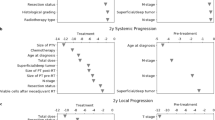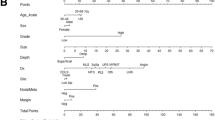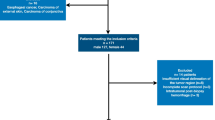Abstract
Many researches have applied machine learning methods to find associations between radiomic features and clinical outcomes. Random survival forests (RSF), as an accurate classifier, sort all candidate variables as the rank of importance values. There was no study concerning on finding radiomic predictors in patients with extremity and trunk wall soft-tissue sarcomas using RSF. This study aimed to determine associations between radiomic features and overall survival (OS) by RSF analysis. To identify radiomic features with important values by RSF analysis, construct predictive models for OS incorporating clinical characteristics, and evaluate models’ performance with different method. We collected clinical characteristics and radiomic features extracted from plain and contrast-enhanced computed tomography (CT) from 353 patients with extremity and trunk wall soft-tissue sarcomas treated with surgical resection. All radiomic features were analyzed by Cox proportional hazard (CPH) and followed RSF analysis. The association between radiomics-predicted risks and OS was assessed by Kaplan–Meier analysis. All clinical features were screened by CPH analysis. Prognostic clinical and radiomic parameters were fitted into RSF and CPH integrative models for OS in the training cohort, respectively. The concordance indexes (C-index) and Brier scores of both two models were evaluated in both training and testing cohorts. The model with better predictive performance was interpreted with nomogram and calibration plots. Among all 86 radiomic features, there were three variables selected with high importance values. The RSF on these three features distinguished patients with high predicted risks from patients with low predicted risks for OS in the training set (P < 0.001) using Kaplan–Meier analysis. Age, lymph node involvement and grade were incorporated into the combined models for OS (P < 0.05). The C-indexes in both two integrative models fluctuated above 0.80 whose Brier scores maintained less than 15.0 in the training and testing datasets. The RSF model performed little advantages over the CPH model that the calibration curve of the RSF model showed favorable agreement between predicted and actual survival probabilities for the 3-year and 5-year survival prediction. The multimodality RSF model including clinical and radiomic characteristics conducted high capacity in prediction of OS which might assist individualized therapeutic regimens. Level III, prognostic study.




Similar content being viewed by others
References
Gutierrez JC, Perez EA, Franceschi D, Moffat FL Jr, Livingstone AS, Koniaris LG (2007) Outcomes for soft-tissue sarcoma in 8249 cases from a large state cancer registry. J Surg Res 141(1):105–114
Crago AM, Brennan MF (2015) Principles in management of soft tissue sarcoma. Adv Surg 49(1):107–122
Miwa S, Yamamoto N, Hayashi K, Takeuchi A, Igarashi K, Tsuchiya H (2019) Therapeutic targets for bone and soft-tissue sarcomas. Int J Mol Sci. 20(1):1
Patel DB, Matcuk GR Jr (2018) Imaging of soft tissue sarcomas. Chin Clin Oncol 7(4):35
Aerts HJ, Velazquez ER, Leijenaar RT, Parmar C, Grossmann P, Carvalho S, Bussink J, Monshouwer R, Haibe-Kains B, Rietveld D, Hoebers F, Rietbergen MM, Leemans CR, Dekker A, Quackenbush J, Gillies RJ, Lambin P (2014) Decoding tumour phenotype by noninvasive imaging using a quantitative radiomics approach. Nat Commun 5:4006
Gillies RJ, Kinahan PE, Hricak H (2016) Radiomics: images are more than pictures, they are data. Radiology 278(2):563–577
Lambin P, Leijenaar RTH, Deist TM, Peerlings J, de Jong EEC, van Timmeren J, Sanduleanu S, Larue R, Even AJG, Jochems A, van Wijk Y, Woodruff H, van Soest J, Lustberg T, Roelofs E, van Elmpt W, Dekker A, Mottaghy FM, Wildberger JE, Walsh S (2017) Radiomics: the bridge between medical imaging and personalized medicine. Nat Rev Clin Oncol 14(12):749–762
O’Sullivan F, Roy S, O’Sullivan J, Vernon C, Eary J (2005) Incorporation of tumor shape into an assessment of spatial heterogeneity for human sarcomas imaged with FDG-PET. Biostatistics 6(2):293–301
Skamene SR, Rakheja R, Dahlstrom KR, Roberge D, Nahal A, Charest M, Turcotte R, Hickeson M, Freeman C (2014) Metabolic activity measured on PET/CT correlates with clinical outcomes in patients with limb and girdle sarcomas. J Surg Oncol 109(5):410–414
Wolsztynski E, O’Sullivan F, Keyes E, O’Sullivan J, Eary JF (2018) Positron emission tomography-based assessment of metabolic gradient and other prognostic features in sarcoma. J Med Imaging (Bellingham) 5(2):024502
Spraker MB, Wootton LS, Hippe DS, Ball KC, Peeken JC, Macomber MW, Chapman TR, Hoff MN, Kim EY, Pollack SM, Combs SE, Nyflot MJ (2019) MRI radiomic features are independently associated with overall survival in soft tissue sarcoma. Adv Radiat Oncol 4(2):413–421
Peeken JC, Bernhofer M, Spraker MB, Pfeiffer D, Devecka M, Thamer A, Shouman MA, Ott A, Nüsslin F, Mayr NA, Rost B, Nyflot MJ, Combs SE (2019) CT-based radiomic features predict tumor grading and have prognostic value in patients with soft tissue sarcomas treated with neoadjuvant radiation therapy. Radiother Oncol 135:187–196
Zhang B, He X, Ouyang F, Gu D, Dong Y, Zhang L, Mo X, Huang W, Tian J, Zhang S (2017) Radiomic machine-learning classifiers for prognostic biomarkers of advanced nasopharyngeal carcinoma. Cancer Lett 403:21–27
Ishwaran H, Kogalur U, Blackstone E, Lauer M (2008) Random survival forests. Ann Appl Stat 2:1
Ishwaran H, Kogalur UB, Xi C, Minn AJ (2011) Random survival forests for high-dimensional data. Stat Anal Data Min 4(1):115–132
Leger S, Zwanenburg A, Pilz K, Lohaus F, Linge A, Stuschke M, Balermpas P, Rödel C, Ganswindt U, Belka C, Pigorsch S, Combs SE, Mönnich D, Zips D, Krause M, Baumann M, Troost EGC, Löck S, Richter C, Zöphel K, Kotzerke J, Schreiber A, Tinhofer I, Budach V, Sak A (2017) A comparative study of machine learning methods for time-to-event survival data for radiomics risk modelling. Sci Rep 7(1):13206
Nardone V, Tini P, Nioche C, Mazzei MA, Carfagno T, Battaglia G, Pastina P, Grassi R, Sebaste L, Pirtoli L (2018) Texture analysis as a predictor of radiation-induced xerostomia in head and neck patients undergoing IMRT. Radiol Med 123(6):415–423
Ishwaran H, Kogalur UB, Gorodeski EZ, Minn AJ, Lauer MS (2010) High-dimensional variable selection for survival data. J Am Stat Assoc 105(489):205–217
Schoop R, Beyersmann J, Schumacher M, Binder H (2011) Quantifying the predictive accuracy of time-to-event models in the presence of competing risks. Biom J 53(1):88–112
Gerds TA, Andersen PK, Kattan MW (2014) Calibration plots for risk prediction models in the presence of competing risks. Stat Med 33(18):3191–3203
Acem I, Verhoef C, Rueten-Budde AJ, Grünhagen DJ, van Houdt WJ, van de Sande MAJ (2020) Age-related differences of oncological outcomes in primary extremity soft tissue sarcoma: a multistate model including 6260 patients. Eur J Cancer 141:128–136
Riad S, Griffin AM, Liberman B, Blackstein ME, Catton CN, Kandel RA, O’Sullivan B, White LM, Bell RS, Ferguson PC, Wunder JS (2004) Lymph node metastasis in soft tissue sarcoma in an extremity. Clin Orthop Relat Res 426:129–134
Lazarides AL, Kerr DL, Nussbaum DP, Kreulen RT, Somarelli JA, Blazer DG 3rd, Brigman BE, Eward WC (2019) Soft tissue sarcoma of the extremities: what is the value of treating at high-volume centers? Clin Orthop Relat Res 477(4):718–727
Coindre JM (2006) Grading of soft tissue sarcomas: review and update. Arch Pathol Lab Med 130(10):1448–1453
Sanmamed N, Berlin A, Beiki-Ardakani A, Ballantyne H, Simeonov A, Chung P (2018) Magnetic resonance imaging-guided brachytherapy re-irradiation for isolated local recurrence of soft tissue sarcoma. Cureus 10(4):e2457
Park SY, Chung HW, Chae SY, Lee JS (2016) Comparison of MRI and PET-CT in detecting the loco-regional recurrence of soft tissue sarcomas during surveillance. Skeletal Radiol 45(10):1375–1384
Kusunoki S, Terao Y, Ujihira T, Fujino K, Kaneda H, Kimura M, Ota T, Takeda S (2017) Efficacy of PET/CT to exclude leiomyoma in patients with lesions suspicious for uterine sarcoma on MRI. Taiwan J Obstet Gynecol 56(4):508–513
Lauenstein TC, Sharma P, Hughes T, Heberlein K, Tudorascu D, Martin DR (2008) Evaluation of optimized inversion-recovery fat-suppression techniques for T2-weighted abdominal MR imaging. J Magn Reson Imaging 27(6):1448–1454
Amini B, Jessop AC, Ganeshan DM, Tseng WW, Madewell JE (2015) Contemporary imaging of soft tissue sarcomas. J Surg Oncol 111(5):496–503
Fisher SM, Joodi R, Madhuranthakam AJ, Öz OK, Sharma R, Chhabra A (2016) Current utilities of imaging in grading musculoskeletal soft tissue sarcomas. Eur J Radiol 85(7):1336–1344
Gronchi A, Ferrari S, Quagliuolo V, Broto JM, Pousa AL, Grignani G, Basso U, Blay JY, Tendero O, Beveridge RD, Ferraresi V, Lugowska I, Merlo DF, Fontana V, Marchesi E, Donati DM, Palassini E, Palmerini E, De Sanctis R, Morosi C, Stacchiotti S, Bagué S, Coindre JM, Dei Tos AP, Picci P, Bruzzi P, Casali PG (2017) Histotype-tailored neoadjuvant chemotherapy versus standard chemotherapy in patients with high-risk soft-tissue sarcomas (ISG-STS 1001): an international, open-label, randomised, controlled, phase 3, multicentre trial. Lancet Oncol 18(6):812–822
Wang H, Zhou L (2017) Random survival forest with space extensions for censored data. Artif Intell Med 79:52–61
Oberije C, De Ruysscher D, Houben R, van de Heuvel M, Uyterlinde W, Deasy JO, Belderbos J, Dingemans AM, Rimner A, Din S, Lambin P (2015) A validated prediction model for overall survival from stage III non-small cell lung cancer: toward survival prediction for individual patients. Int J Radiat Oncol Biol Phys 92(4):935–944
Tang XR, Li YQ, Liang SB, Jiang W, Liu F, Ge WX, Tang LL, Mao YP, He QM, Yang XJ, Zhang Y, Wen X, Zhang J, Wang YQ, Zhang PP, Sun Y, Yun JP, Zeng J, Li L, Liu LZ, Liu N, Ma J (2018) Development and validation of a gene expression-based signature to predict distant metastasis in locoregionally advanced nasopharyngeal carcinoma: a retrospective, multicentre, cohort study. Lancet Oncol 19(3):382–393
Akai H, Yasaka K, Kunimatsu A, Nojima M, Kokudo T, Kokudo N, Hasegawa K, Abe O, Ohtomo K, Kiryu S (2018) Predicting prognosis of resected hepatocellular carcinoma by radiomics analysis with random survival forest. Diagn Interv Imaging 99(10):643–651
Wang L, Dong T, Xin B, Xu C, Guo M, Zhang H, Feng D, Wang X, Yu J (2019) Integrative nomogram of CT imaging, clinical, and hematological features for survival prediction of patients with locally advanced non-small cell lung cancer. Eur Radiol 29(6):2958–2967
Gittleman H, Lim D, Kattan MW, Chakravarti A, Gilbert MR, Lassman AB, Lo SS, Machtay M, Sloan AE, Sulman EP, Tian D, Vogelbaum MA, Wang TJC, Penas-Prado M, Youssef E, Blumenthal DT, Zhang P, Mehta MP, Barnholtz-Sloan JS (2017) An independently validated nomogram for individualized estimation of survival among patients with newly diagnosed glioblastoma: NRG oncology RTOG 0525 and 0825. Neuro-Oncol 19(5):669–677
Sica GT (2006) Bias in research studies. Radiology 238(3):780–789
Yasaka K, Akai H, Mackin D, Court L, Moros E, Ohtomo K, Kiryu S (2017) Precision of quantitative computed tomography texture analysis using image filtering: A phantom study for scanner variability. Medicine (Baltimore) 96(21):e6993
Funding
The authors did not receive support from any organization for the submitted work.
Author information
Authors and Affiliations
Contributions
XM, YY, YW and XD made substantial contributions to conception and design, and revised the manuscript critically for important intellectual content. XM revised the manuscript and gave final approval of the version to be published. All authors read and approved the final manuscript.
Corresponding author
Ethics declarations
Conflict of interest
All authors certify that they have no affiliations with or involvement in any organization or entity with any financial interest or non-financial interest in the subject matter or materials discussed in this manuscript.
Research involving human participants and/or animals
The procedures followed for the present Original Research were in accordance with the declaration of Helsinki.
Informed consent
Each author certified that his or her institution approved the human protocol for this investigation and that all investigations were consistent with ethical principals of research. This work performed by West China Hospital, Sichuan University, Chengdu, Sichuan, China.
Additional information
Publisher's Note
Springer Nature remains neutral with regard to jurisdictional claims in published maps and institutional affiliations.
Rights and permissions
About this article
Cite this article
Yang, Y., Ma, X., Wang, Y. et al. Prognosis prediction of extremity and trunk wall soft-tissue sarcomas treated with surgical resection with radiomic analysis based on random survival forest. Updates Surg 74, 355–365 (2022). https://doi.org/10.1007/s13304-021-01074-8
Received:
Accepted:
Published:
Issue Date:
DOI: https://doi.org/10.1007/s13304-021-01074-8




